CHOCOLATL Eau de Parfum by Euphorium Brooklyn for Women and Men.

FRAGRANCE PROFILE
Mexican Cocoa, Spice & Piloncello, Tzapotl fruit, Vanilla & Honey, and
Balsam & Musk accords
CHOCOLATL Eau de Parfum by Euphorium Brooklyn:
– Sourced from the Finest Rare and Exotic Oils, Tinctures and
Absolutes
– Traditional Euphoria Inducing Komodo Process
– Handcrafted in Brooklyn, New York
– Available in 50ML (with additional bulb atomizer), 30ML, & 8ML spray top bottles
– Also available in the VOLUPTUARY SET

FRAGRANCE NOTES
Mexican Cocoa, Nutmeg, Clove, Cassia, Black Pepper, Myrrh, Coffee, Neroli, Davana, Raisin, Prune, Labdanum, Angelica Root, Honey, Vanilla, Caramel, Palm Sugar, Copal, Peru Balsam, Benzoin, Tolu Balsam, Castoreum, Musk

PERFUMER RUDOLPH KOMODO
“CHOCOLATL. Warm liquid trickles slowly down my skin and I am lost. Lost to daylight. Lost to thought. I am found in my pleasure. Found in a decadence which is rich and warm, spiced and honeyed with delight. Warm liquid trickles slowly on my skin. CHOCOLATL I am lost.” – R. Komodo, (Visionaries Magical, Knowing & Transcendence 1854)
CHOCOLATL ETUDES from Euphorium Brooklyn on Vimeo.

PERFUMER’S INSPIRATION
The CHOCOLATL fragrance accord came to Rudolph Komodo while convalescing in a Mexico in 1855 to soothe, comfort, inspire, and transcend himself. He began with a dark cocoa sweetened with palm sugar and warmed with rich Mexican vanilla bean. Deep notes of Javanese coffee and myrrh were added to support the fragrant cocoa.

Bright pine notes of incense and freshly cracked black pepper offer a clangorous fanfare to introduce the layers of spices that follow. Notes sparkle and weave like the burgundy and chocolate brown fibers in the Ikat weavings of Sumatra. Sharp Indonesian nutmeg and bright cardamon form harmonies with warm clove and “Kayu Manis” or “Sweet Wood” cinnamon bark.

With senses awakened and piqued, now an indulgence of honeyed, ripened fermented fruits. Rich prune, raisin and dates sweeten and seduce our palette. CHOCOLATL’s final notes soften to sweet musk and the vanilla touched balsams of ancient woods. Rich spices whisper like a distant incense.

PERFUMER’S INSPIRATION (extended)
Rudolph Komodo knew well of cocoa, coffee and spices as a child in Java, Indonesia. He would slowly brew his own cocoa variation of a traditional unfiltered “kopi tubruk” coffee with an Arabic twist he had learned from an Omani perfumer he knew in Bandung. The freshly ground dark coffee, still warm from the roaster, would be carefully measured. Cocoa and palm sugar would follow to complete the accord.
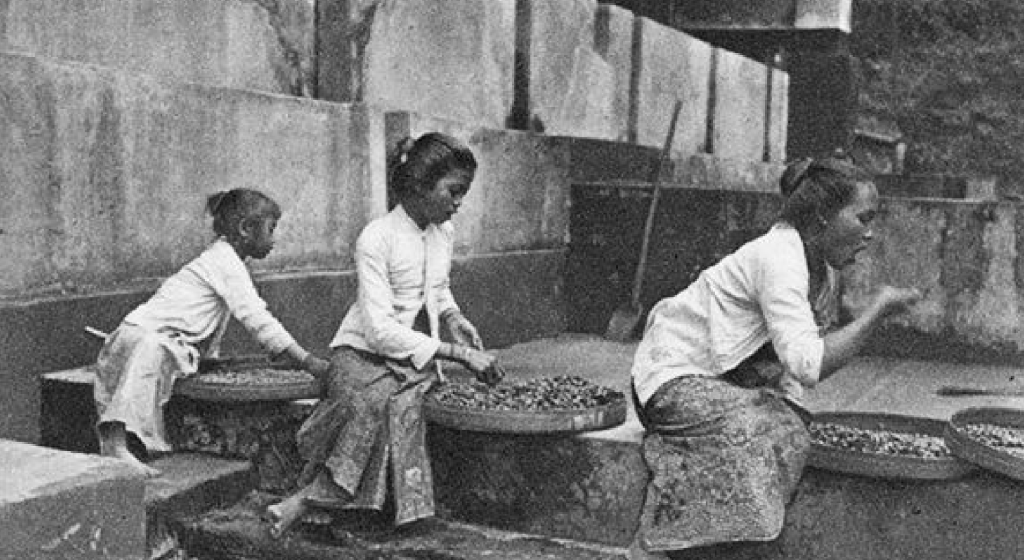
Stirring the cocoa into a paste with a few drops of water and staring at the fire, Komodo would gently mix the precious brew until the sugar began to caramelize and bubble up. After grinding in his stone mortar, he would experiment with additions of various amounts of fragrant clove, nutmeg and cardamon. Young Komodo would observe and record how each element in measure would add to and exalt certain notes in the cocoa while other notes would be masked or muted by the spices.
Komodo developed his first true affinity for drinking pure cocoa and its sensual potential as a young man in the salon’s of Batavia era Amsterdam.

Komodo’s first window into this protected world of exotic refinement and opulence, his 1850 grand tour of Europe with the Sultan of Komodo’s court, began and ended for the young man with the beautiful creatures of Amsterdam.

Rudolph quietly marveled in reverence at the Dutch cocoa ceremonies he observed. Usually officiated and attended by cream coloured, silk robed fawns of polite society, Rudolph esteemed how the elegant and delicate porcelain service contained and decanted this sensual warm liquid into sets of ornate translucent-thin, gilded cups. This liquid so primal and powerful. It was hard for him to imagine such rich indulgent sips to be measured in the gentile refinement of it all.
Rudolph developed an appreciation for “proper presentation”. (see “The Theatre of Ritual and Manner in Modern Transcenedalism” – R. Komodo, 1852) He was soon to know of the decadent passions of the salons of Amsterdam and the creatures with porcelain complexions and passions that enveloped and transported him into warm liquid like the CHOCOLATL he would later create.
SOUTH and CENTRAL AMERICAN TRAVELS
Rudolph Komodo traveled to Brasil in 1855 with the sponsorship of the Sultanate and the backing of a wealthy German business man involved in the petrochemical industry. While sourcing materials in the Mato Grosso region, Komodo became entangled in the affairs of Dr. Christian Rosenkruez, his wife Sybil, Segfried Humboldt and a Bororo tribe. (see “The Bororo Affair”, R. Komodo, 1857. see “The Great Journey of Knowing-Becoming” Humboldt-Rosenkreuz, 1855)

Harrowing travels from Brasil to Mexico in 1855 allowed Komodo to continue his foraging for and study of botanical psychotropics and entheogens throughout South and Central America. From the fragrant Peru Balsam, Cassia and Guaiacwood to DMT rich plants and fermented fruits in honeyed macerations, Komodo sniffed, sampled and drank his way up the continent.

With funds secured in trade for his herbal elixers, Komodo was quick to establish the “Euphorium” in a once luxurious, but by then, largely disheveled villa in Mexico City. It was both a location to sell his wares and also a haven for his clients to indulge in their vices. In Mexico, Komodo’s journey came to a euphoric climax, but not a conclusion.
Komodo had a period of exhaustive sensual research for CHOCOLATL. He spent several weeks living in apartments at the Euphorium in an opiatic haze, bathing in warmed CHOCOLATL and frequently receiving honeyed fruit massages and spiced incense stimulation. Seeking to create an extended orgasmic delirium, Rudolph also sank into a world of carnal abandon and drug addled sensual experimentation during this time. (- see, “The Velvet Spoon of Señora Bustelo’s Apartments and Other Tales of an Enlighten Lizard” – R. Komodo, 1856)

Komodo’s decadence reached its apex during the famed Copal harvest of 1855. Komodo claimed to have left his body, returned to Indonesia and lived for 5 years as a bonang player in West Java (metalophone in traditional Gamelan Degung ensemble) before returning to his body in Mexico and regaining consciousness after being comatose for 72 hours.

During his brief coma, Komodo had several visions related to his concept of “Harmonic Resonance” and the underpinnings of his “Komodo Process” as employed by the Euphorium Brooklyn. Komodo claimed that while living in an alternate reality in Indonesia as a Gamelan player, he was required to memorize lengthy compositions and discovered that he could associate both sound frequencies and colors to scent notes as a mnemonic device. Scent, in turn could be modeled in sound. Certain accords could be resonated with sound waves as they macerate to induce specific fragrant properties. (see R. Komodo “Komodo Process Part 1”, 1856)
Komodo transcribed several of the compositions he was able to recall upon regaining consciousness. These compositions comprise the volume, “Three Sundanese Modes for Fragrant Induction and Komodo Processing” (1851).

Large harp like systems and extensive mechanical musical devices were employed by the Euphorium Bile Works at different stages of the Komodo Process.
Komodo’s establishment of a “Euphorium” salon in Mexico City afforded him great political influence. With the young, decadent, and powerful of Mexico frequenting his establishment, the “La Reforma” movement was began in Komodo’s velvet apartments. (mid 19th century movement characterized by liberal reforms and the transformation of Mexico into a nation state).

Komodo developed a friendship with José Ignacio Gregorio Comonfort (President of Mexico 1855). Reported to have been influenced by the pagan ritualism he practiced with Komodo, Comonfort became convinced that the Church’s political power had to be curbed, and came over to the side of the Liberals to lead a political revolt.

NOTES ON FRAGRANT MATERIALS RELATED TO COCOA
– CHOCOLATL, meaning warm liquid. The word Cocoa derives from the Spanish word cacao, which in turn originates in the Nahuatl word cacahuatl. (cacao + atl, Nahuatl for water/liquid).

– The first people to make cocoa were the ancient tribes of Mexico and Central America, including the Incas, Aztec and Maya.

– It was common to sweeten the drink with maguey syrup (aguamiel) or honey. Spices would be included to create a cacao paste specific to a certain personal or regional recipe. Common ingredients included: earflower, heart flower, cacao flower, anise, vanilla, zapote seed, pepper leaf, root beer plant, allspice berry, red chili, and maguey flower.
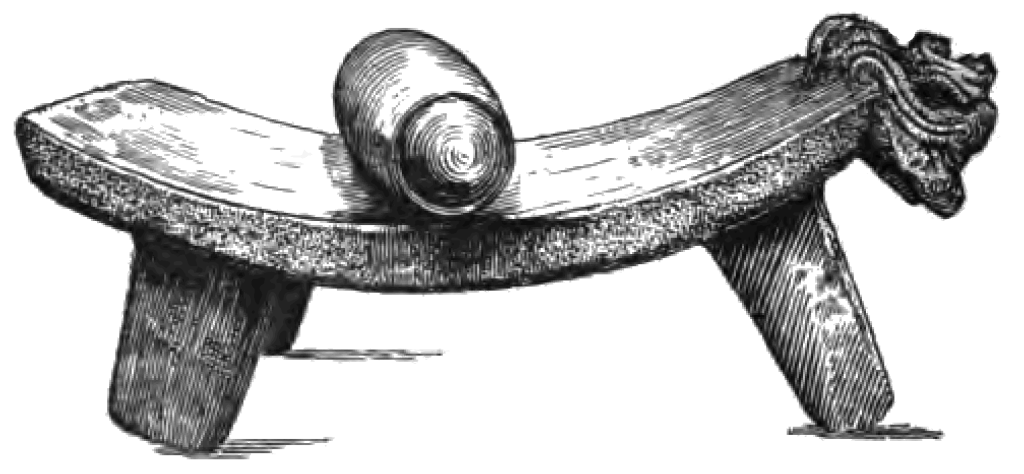
MAYA COCOA RECIPES
iximte’el kakaw – “Maize Tree” Cacao
y-utal kakaw – “Sustenance” Cacao
tshih te’el kakaw – “Tree-Fresh” Cacao
k’ab kakaw – “Juice” Cacao [using honey]
om kakaw – “frothy” or “foaming” cacao
– The people of Cholula, Mexico, made a cacao beverage using water in which the knives used in human sacrifice had been washed.
– The Florentine Codex, Sahagún recorded that the ‘heart’ and ‘blood’ were metaphors for cacao. Both the heart and the cacao pod served as containers of divine fluid; blood and chocolate.
– Cacao had been traditionally exchanged between intermarrying families and could be taken as a symbol of mixing family bloodlines.

VANILLA
– Vanilla was first cultivated by the Aztecs and it was used as a flavoring for cocoa.
– Europeans became aware of both chocolate and vanilla in the 1520s.
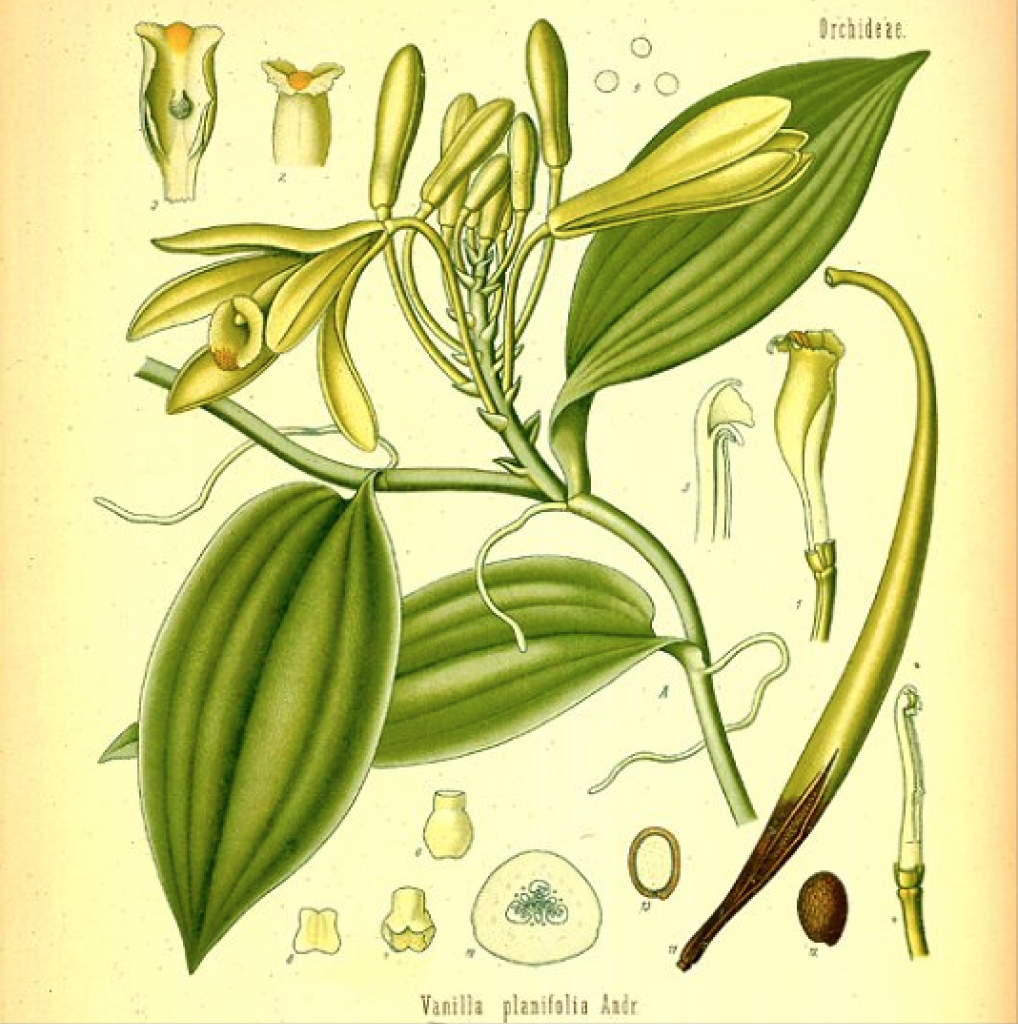
– Vanilla is the only edible fruit from an orchid.
– The Totonac people, who inhabit the East Coast of Mexico in the present-day state of Veracruz, were the first to cultivate vanilla.
– In Totonac mythology, the tropical orchid was born when Princess Xanat, forbidden by her father from marrying a mortal, fled to the forest with her lover. The lovers were captured and beheaded. Where their blood touched the ground, the vine of the tropical orchid grew.
– Dr. Christian Rosenkruez, doctor, scientist, perfumer, and partner to Komodo in the Euphorium Bile Works, introduced Komodo to his work in synthesizing vanillin.
– The vanillin chemical was first isolated in 1858 by Nicolas -Theodore Gobley.
– In 1874, Ferdinand Tiemann and Whilhelm Haarmann identified vanillin’s chemical structure, and found a synthesis for it from coniferin, found in pine bark in Holzminden, Germany. Though uncredited, this breakthrough was thought to have been largely informed by Dr. Christian Rosenkruez’ earlier work with Guaiacol.
– Rudolph Komodo found a combination of vanilla notes blended from natural and synthetic sources allowed him great precision and flexibility in sculpting the notes and duration of the vanilla bouquet in CHOCOLATL.
PALA
Indonesian Nutmeg

– Known as pala (kepulaga) in Indonesia, it is one of the two spices (and also mace) derived from several species of tree in the genus Myristica. Myristica fragrant, is an evergreen tree indigenous to the Banda Islands of Indonesia.
– An 1883 report from Mumbai noting that “the Hindus of West India take nutmeg as an intoxicant”, and records that the spice has been used for centuries as a form of snuff in rural eastern Indonesia and India.
– In 1829, the Czech physiologist Jan Evangelista Purkinje, ingested three ground nutmegs with a glass of wine at the urging of Rudolph Komodo. He recorded headaches, nausea, hallucinations, and a sense of euphoria that lasted for several days.
KRETEK
Indonesian Clove
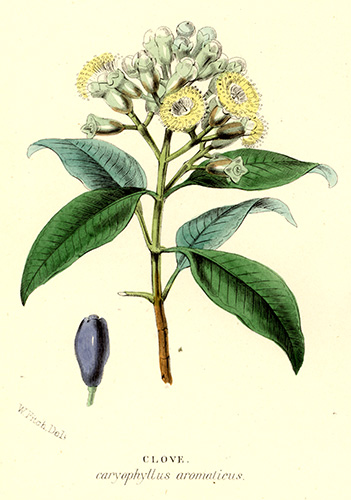
– Clove cigarettes originating in the 19th century contained benzoin resin, nutmeg, cumin, clove, and tobacco and were wrapped in banana leaves. Rudolph Komodo employed two personal Kretek rollers for most of his adult life.
– The word “kretek” itself is an onomatopoetic term for the crackling sound of burning cloves.
KAYU MANIS
Indonesian Cinnamon
Sweet Wood
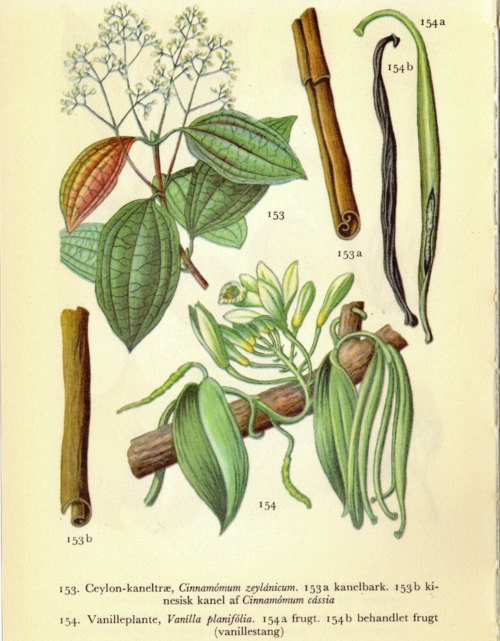
– Cinnamomum burmannii, also known as Indonesian cinnamon, Padang cassia, Batavia cassia, or korintje, is native to Indonesia and is one of several plants whose bark is sold as the spice cinnamon.
– Cinnamomum burmannii oil contains no eugenol, but higher amounts of coumarin than cassia and Ceylon cinnamon.
TZAPOTL
Mexican Zapote Negro Fruit
– A fruit with the flavors of chocolate, nutty, and dark cooked fruits.
– From the Nahuatl “tzapotl,” zapote is a term for a variety of soft, edible fruits.

– Zapote negro is a baseball-sized, round fruit known as the “chocolate pudding fruit” for its black flesh that sweetens and softens before collapsing as it ripens.
– The fruit is sweet and nutty, with notes of stewed prune and chocolate. It can be eaten raw, or can be cooked with sugar and spices.
HONEY
– The Maya people of the Yucatan have practiced beekeeping for thousands of years.

– The Maya considered the stingless melliponine bee (Apidae melliponinae), native to the tropical forests of the Yucatan peninsula, to be a link to the spirit world given to them by the bee god, Ah Muzen Cab.
– One of the four surviving Maya books, the Madrid Codex, is devoted to bees and beekeeping.
– Tajonal (Viguiera dentata) is known in English as “Toothleaf Goldeneye” and is in the aster family. It occurs primarily in Mexico and South America and produces a uniquely refined and fragrant honey.
BALCHÉ/ ACACIA
– Numerous acacia species have been used as medicine, entheogens, and for making incense.

– In Mexico, the root of Acacia angustifolia is used as an additive to pulque, a fermented psychoactive agave beverage.
– Acacia cornigera is a South American species used in the preparation of the Mayan ritual drink known as balche.
– Balché is a mildly intoxicating beverage common among ancient and indigenous cultures in areas of what are now Mexico and upper Central America.
– The mixture of bark, roots, honey and water begins to ferment immediately. It is often consumed during rituals and was believed to have magic powers.

– The Lacandon believe that the gods gave balché rituals to them. The Lacandon chant incantations while preparing the balché.
– The Lacandon call the balché brewer “Lord of the Balché” and they identify him with Bohr or Bol, the god of inebriation.
COPAL
– The word copal is derived from the Nahuatl language word copalli, meaning incense.
– Indigenous Mesoamerican societies saw a close relationship between maize and copal, maize being primarily a food for humans, and copal, the “blood” of trees, being primarily a food for deities.

– Copal was used as incense offerings to the deities. “Though the gods do not eat as mortals do, they must imbibe the products of human ritual, primarily the smoke of incense”
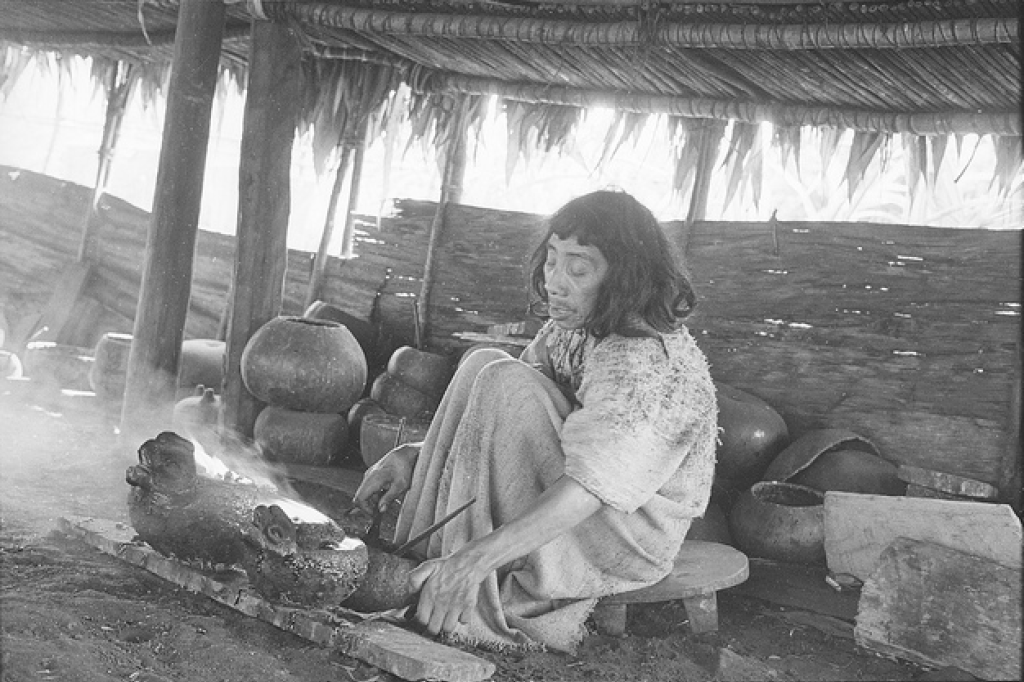
– Villagers call rituals xochitlalia. Rituals often run continuously for several days at a time, producing in participants a dreamlike state of semi-exhaustion.
– Rituals are accompanied by lilting, repetitive guitar and violin music called xochisones, a Nahuatl-Spanish term meaning “flower sounds”. In larger events, lines of dancers perform in ornate headdresses while shaking gourd rattles. Shamans and their helpers construct elaborate altars decorated with greenery and flowers and load them with offerings and rows of lighted beeswax candles. One or more copal incense braziers pour out billows of resinous, aromatic smoke as the shaman sacrifices chickens or turkeys and dances wildly holding bundles of cut paper figures.

– Father Jose Luis Guerrero who notes that in Mexico during the 16th cent, the shaman-priests inhaled smoke from copal to enter the trance state, waving the smoke to the noses from the smoking censor.
– The Sierra Popoluca, a Zoquean group living on the north end of the Isthmus of Tehuantepec, use copal smoke in connection with hunting. The jawbones of deer obtained in the hunt are saved and smoked with copal in order to allow the souls of these animals to return to their spirit home in the charge of the Master of Animals.

– In Indonesia it is noted, “a widespread technique for engendering trance is the inhalation of juniper smoke”. In Bali, incense smoke used to be inhaled for the induction of trance as part of an ancient dance ritual.
CHOCOLATL was awarded “Best of Scent 2015” by Pam Barr, cafleurebon.com

Chocolatl – Euphorium Brooklyn (Stephen Dirkes) Deciding which of this deliriously-prolific house’s offerings I liked best in 2015 was a daunting task. But their most recent and only gourmand offering won out – Spicy Mexican chocolate, and a citrus note that is also redolent of chocolate pudding? My inner child wants it RIGHT NOW. – Pam Barr, cafleurebon.com






































